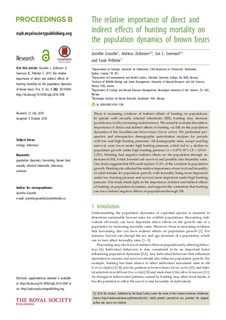| dc.contributor.author | Gosselin, Jacinthe | |
| dc.contributor.author | Zedrosser, Andreas | |
| dc.contributor.author | Swenson, Jon | |
| dc.contributor.author | Pelletier, Fanie | |
| dc.date.accessioned | 2014-12-19T09:09:57Z | |
| dc.date.accessioned | 2015-01-27T20:40:03Z | |
| dc.date.accessioned | 2017-04-19T12:24:26Z | |
| dc.date.available | 2014-12-19T09:09:57Z | |
| dc.date.available | 2015-01-27T20:40:03Z | |
| dc.date.available | 2017-04-19T12:24:26Z | |
| dc.date.issued | 2014 | |
| dc.identifier.citation | Gosselin, J., Zedrosser, A., Swenson, J. & Pelletier, F. The relative importance of direct and indirect effects of hunting mortality on the population dynamics of brown bears. Proceedings of the Royal Society of London. Biological Sciences 2014, 282(1798): | |
| dc.identifier.issn | 1471-2954 | |
| dc.identifier.uri | http://hdl.handle.net/11250/2437939 | |
| dc.description.abstract | There is increasing evidence of indirect effects of hunting on populations. In species with sexually selected infanticide (SSI), hunting may decrease juvenile survival by increasing male turnover. We aimed to evaluate the relative importance of direct and indirect effects of hunting via SSI on the population dynamics of the Scandinavian brown bear (Ursus arctos). We performed prospective and retrospective demographic perturbation analyses for periods with low and high hunting pressures. All demographic rates, except yearling survival, were lower under high hunting pressure, which led to a decline in population growth under high hunting pressure (λ = 0.975; 95% CI = 0.914-1.011). Hunting had negative indirect effects on the population through an increase in SSI, which lowered cub survival and possibly also fecundity rates. Our study suggests that SSI could explain 13.6% of the variation in population growth. Hunting also affected the relative importance of survival and fecundity of adult females for population growth, with fecundity being more important under low hunting pressure and survival more important under high hunting pressure. Our study sheds light on the importance of direct and indirect effects of hunting on population dynamics, and supports the contention that hunting can have indirect negative effects on populations through SSI. | |
| dc.language.iso | eng | |
| dc.relation.uri | http://rspb.royalsocietypublishing.org/content/282/1798/20141840 | |
| dc.rights.uri | http://creativecommons.org/licenses/by/4.0/ | |
| dc.subject | population dynamics | |
| dc.subject | harvesting | |
| dc.subject | brown bear | |
| dc.subject | sexually selected infanticide | |
| dc.subject | behaviour | |
| dc.subject | carnivore | |
| dc.title | The relative importance of direct and indirect effects of hunting mortality on the population dynamics of brown bears | |
| dc.type | Journal article | |
| dc.type | Peer reviewed | |
| dc.date.updated | 2014-12-19T09:09:57Z | |
| dc.description.version | Published version | |
| dc.rights.holder | © 2014 The Authors | |
| dc.subject.nsi | 488 | |
| dc.identifier.cristin | 1185369 | |

